Title: WHAT'S SCIENCE GOT TO DO WITH IT?
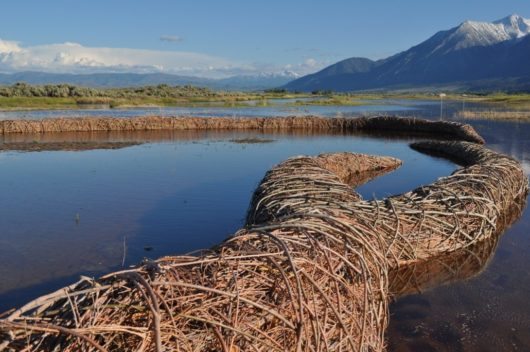
FLOOD PLAIN WALL, Carson City, NV, 2014.
INTRODUCTION
AS SCIENCE INFORMS THE WORKS of more and more artists, the commonalities between scientists and artists are becoming better understood. A familiar theme shared by many in both professions is a large degree of social responsibility. Artists and scientists are passionate about taking on the causes of climate change, soil erosion, species loss, and factors affecting the warming of the earth’s atmosphere. Artists incorporate scientific aspects of soil, water, climate and other elements into their work. Artists study oceans, rivers, and degraded lands and discover aesthetic antidotes in the wake of droughts, over-development, and species loss. Artists address issues of soil erosion, water pollution, species loss, climate change, sea level rise, and myriad other problems harming our natural and built environments through their focused and effective responses making these issues visible to the community.
I. WHERE ARE THE SCIENTISTS?
WHY THEN, ARE THERE NOT more scientists seeking out artists and choosing to work with them on contemporary environmental issues?

LINE OF DEFENSE, New Orleans, LA, 2013.
The relationship of science to environmental art is a dynamic one. Both professions share similar approaches and processes. Scientists searching for new and artistic ways to express their findings often bring artistic approaches to their realm. But artists seeking scientists with which work often find it difficult to initiate collaboration. However, try and imagine moving forward with conservation, climate change remedies, soil conservation, species protection, and restoration of degraded lands without relying on multifaceted collaborations: Artists can, and should, be significantly engaged in such collaborations. The artist-as-activist role is an important strategy for actualizing conservation efforts. Embracing this role can also help further an illusive aspect of this kind of work for artists—access to installation sites.
Projects involving both artists and scientists are usually highly visible and can lead to additional interdisciplinary collaborations. Landowners need knowledge, research, and methodologies that can help them improve soil, correct erosion, conserve water, and direct storm water. Scientific research often extends to the spheres of sociology, demographics, and policy. The ‘big tent’ of environmental art draws on numerous companion disciplines, and aesthetics can be a bridge that sheds light on all efforts engaged in collaboration.
II. LESSONS FROM THE PAST

MULTI-HABITAT SAMPLING, Reno, NV, 2015.
AS AN ARTIST EDUCATED AT A TIME when science wasn’t encouraged as an academic path for girls and women, I found the need to remedy this educational mistake soon after I began to pursue a career in the arts. The amount of data and research I needed to process gave me a different perspective on the natural world. The more technical and scientific information I gathered, the more I began to understand how much environmental loss we have inherited and that we are likely to pass on.
A few decades ago, lands were maintained biologically, simply, organically. Today, advances in agriscience alter the character of rural lands and waterways. In the urban space, the proliferation of impervious surfaces fuels pollution and species loss. Prolonged droughts contribute to soil degradation. Fires expose lands to erosion. Climate change affects the lands, waters, and air that surround all of our homes.
As it has developed, my practice advocates for ‘softer technologies’ using many of the methods of working the land that originated from the Dust Bowl era. Municipal governments throughout the U.S. are ‘re-adopting’ these practices, advocating for and, in some localities, mandating regionally based environmental protections through established best management practices (BMPs). However, healthy practices for preserving public spaces could also be adopted by private landowners, homeowners, and general citizens-at-large. Artists have a role here too—the BMP approach offers opportunities for environmental artists by providing access to sites to create meaningful art experiences through restoration projects.
While governmental agencies run through lengthy processes for regulatory approvals, funding, and site liabilities, artists can help private landowners reach restoration goals based on BMPs. In some of the country’s more politically entangled regions, private landowners are showing the way. In Southern Louisiana, small towns, landowners, and Native American nations are taking on the problems of liquefaction and disappearing lands, lot by lot, island by island. Meanwhile, the U.S. Army Corps of Engineers and a host of regulatory bodies struggle to undo the damage of decades of failed policies before new large-scale solutions can be enacted. Will it be too late? Perhaps policymakers can be galvanized behind protections that individual landowners, artists among them, desire to affect.
III. CAN ART LEAVE NO TRACE?
THE NATIONAL PARK SERVICE (NPS) CHAMPIONS environmental art in their restoration activities, advocating ‘predominately placed art can bring a level of awareness to issues.’ Charles Tracey, NPS landscape architect, believes, ‘Environmental art can capture public attention and animate the goals of community projects.’ When artists incorporate science and engage scientists in their projects, they move beyond creating works ‘that aim to improve the viewers’ understanding of the natural world’1 and directly interact with a site through their environmental works. Choosing to make one’s art a change factor and working in a leave-no-trace manner is a risky, but a highly fulfilling quest for an artist.
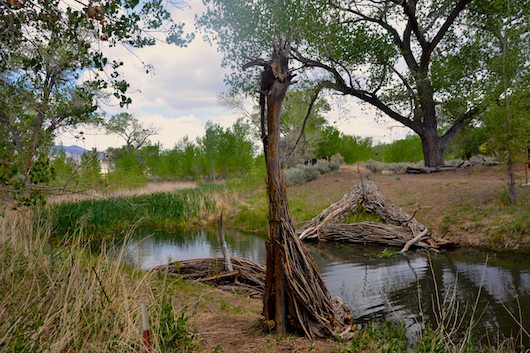
WAS A TREE (with detail), McCarran Ranch Preserve, Truckee River, Patrick, NV, 2015.
My partner, Daniel McCormick, is fond of saying that we take a watershed approach to our work. I like to think about this in an all-inclusive sense, because this is also the way I see the world. The nature of a specific watershed, the history of its ecology, and the characteristics of the natural or built systems help guide our process. We focus on restorative, remedial works that give advantage to the sites were we work. Our work has been described as having a ‘straightforward and efficient bio-remedial dimension.‘2 Some viewers wonder why we let our works ‘disappear.’ That is not our goal, but when the work is designed as a remedial element, an act of restoration is created. We believe that, given the advantage of an artist’s work, even the most degraded elements of a watershed can become part of a ongoing restoration cycle.
The ‘terroir’ of an installation site can provide a powerful aesthetic consideration for artists and scientists alike. Artists may want to take into consideration local characteristics and regional impacts in their approaches. The geology and geography of an installation site are unique and should influence the aesthetics of solutions. Lands, waterways, and ecotones have distinct behaviors, uses, fragility, erosion, productivity, and levels of successful regeneration.
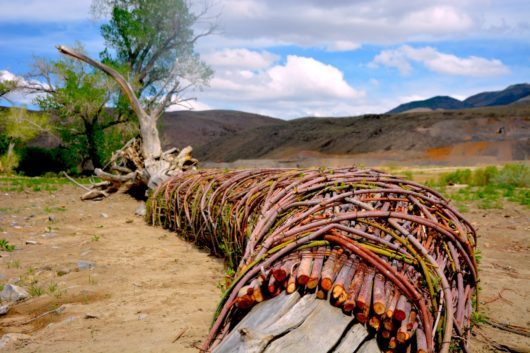
J-HOOK BRAIDED LOG, Reno, NV, 2014.
The specificity of place is where scientific methods can become most influential in the design of an artist’s works. Artists can address restoration issues in both urban and rural watersheds, work in a conservation capacity, and address the different regional textures and behaviors of soil, water, climate, and species. Whether dealing with erosion control, urban runoff, flood plain disruptions, wind disturbances, agricultural issues such as overgrazing, suburban development, water use issues, or drought, artists can contribute real and tangible solutions and to the restoration cycle. An artist’s work can also illuminate the restoration process as it evolves.
When artists and scientists work together, their responses can bring attention to these issues. Artists should be willing to embrace societal issues, varying field conditions, and community outreach. Further, when environmental artists are willing to integrate, as well as reflect scientific research, this collective knowledge can become an integral part of the solution. Artists have been served by science for centuries. If we flip that relationship and base our work in service of science, then the larger body of scientific knowledge can help us address real problems with aesthetic, concrete solutions. For me, as a woman, an artist, and a citizen, these acts of restoration take on personal significance, as I ponder the environmental loss I will inevitably leave behind.
IV. EXAMPLES OF WATERSHED SCULPTURE
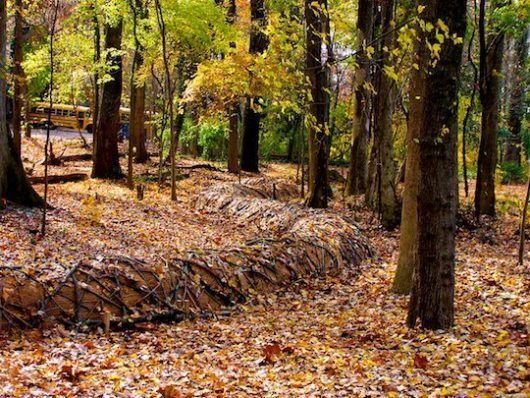
INTERSECTIONS, Charlotte, NC, 2009.
IN NORTH CAROLINA, THE NATIVE RED SOIL displays its mineral content on its surface. However, during heavy rains, urban runoff moves soil out from under traditional ground covers such as grass and ornamental plantings into streets, storm drains, and creeks. We created sculptures that helped spread and aid the absorption of groundwater before it reaches drains and creek, by allowing silt particles to settle with the water. Unexpected results were also realized—returning native sedge grass began to grow in newly created sinks along the length of the sculpture.
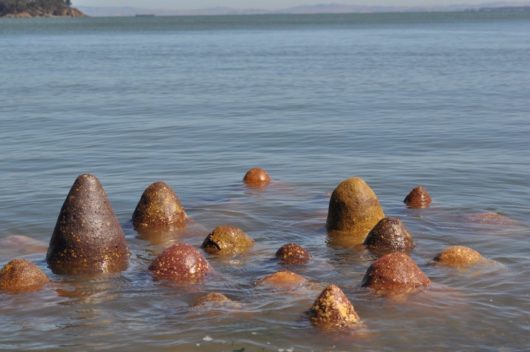
SUBMERGED (forest), San Rafael, CA, 2013-2016.
In the San Francisco Bay Area, we addressed the 150-year history of erosion and siltification and global warming through our sculptures that evolve over time into oyster reefs and natural ‘horizontal levees’ to protect shorelines and help defend against sea level rise.
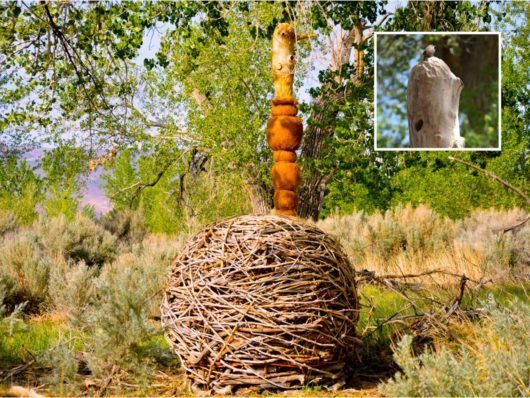
AVIAN HABITAT RESOURCE STRUCTURE, Reno, NV, 2015.
In Northern Nevada, after consulting with scientists from the Nature Conservancy and the Great Basin Bird Observatory, we created five remedial installations in the Carson and Truckee River watersheds. The sculptures retain seasonal floodwaters, reinforce riparian buffers, help create additional wetlands, recharge riparian zone, and concentrate avian resources, while addressing the habitat needs of threatened species. The works, commissioned by the Nevada Museum of Art and the Nature Conservancy, attracted community in ways that no other Conservancy outreach had previously, with volunteers contributing 2,300 hours to complete the projects. Bill Fox, Director of the Center for Art + Environment at the Nevada Museum of Art, said, ‘The work that Daniel and Mary do is unique, but part of a worldwide movement that uses art to address environmental remediation.’3
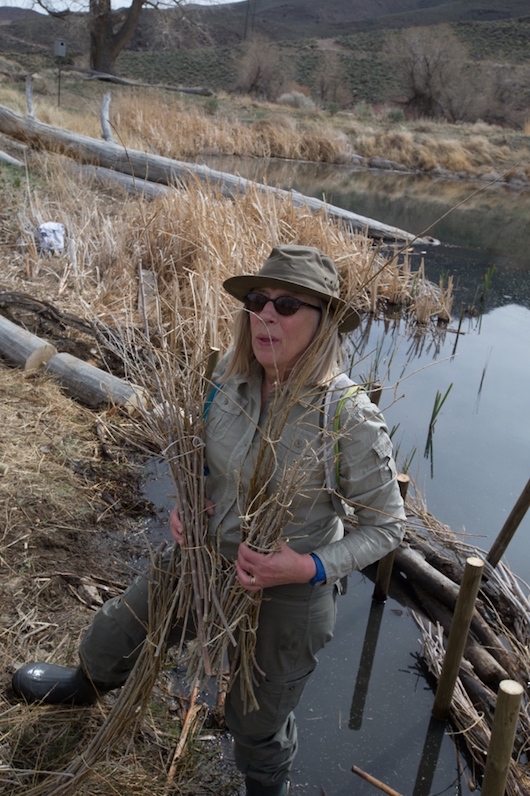
MARY O’BRIEN, TRUCKEE RIVER, MCCARRAN RANCH PRESERVE, THE NATURE CONSERVANCY, RENO, NEVADA. Photo credit: Tim Torell, DWI
Mary O’Brien is a sculptor who collaborates on environmental installations with her partner Daniel McCormick in their practice, Watershed Sculpture. These works are founded on the principle that artists, in collaboration with other disciplines, can create works that encourage sustainability and citizen stewardship. See <watershedsculpture.com>’
END NOTES
2 Valerie Behiery, in Malcolm Cooper and Abhik Chakraborty, eds., Rivers and Society: Landscapes, Governance and Livelihoods, Earthscan Studies in Water Resource Management. “Art Custodians of Our Rivers: Basia Irland, Watershed Sculpture, and Ichi Ikeda’ (Routledge, forthcoming, May 2017).
IMAGE CAPTIONS
FLOOD PLAIN WALL, Carson City, NV, 2014. Consisting of woven fascine on the Carson River, this installation is an inquiry into present-day relationships between community, land, and water involving over 1,600 donated hours from local volunteers. Photo © Mary O’Brien.
LINE OF DEFENSE, New Orleans, LA, 2013. This environmental installation for species restoration and storm surge mitigation incorporated recycled mixed-media and newly planted Bald Cypress seedlings on a 1/4 acre island in the Mississippi Delta in Southern Louisiana. Photo © Mary O’Brien.
MULTI-HABITAT SAMPLING, Reno, NV, 2015. Providing five habitat microenvironments for native frogs, lizards, ground bees, birds, and willows, this work includes woven Red Willow and cottonwood. Created in collaboration with the Nature Conservancy of Nevada and the Nevada Museum of Art. Photo © Mary O’Brien.
WAS A TREE (with detail), McCarran Ranch Preserve, Truckee River, Patrick, NV, 2015. Cottonwood and live-staked Red Willow provide habitat sculpture for wood ducks, Western pond turtles, and reptiles. Created in collaboration with the Nature Conservancy of Nevada and the Nevada Museum of Art. Photo © Mary O’Brien.
J-HOOK BRAIDED LOG, Reno, NV, 2014. Providing flow control in the lower flood plain along the Truckee River, this work, consisting of woven, live-staked Arroyo Willow and a downed cottonwood tree, was made possible through collaboration with the Nature Conservancy and the Nevada Museum of Art. Photo © Mary O’Brien.
INTERSECTIONS, Charlotte, NC, 2009. This urban runoff remediation consists of willow, dogwood, and elderberry woven together to mitigate storm water runoff from urban development into Charlotte’s largest flowing creek. Photo © Mary O’Brien.
SUBMERGED (forest), San Rafael, CA, 2013-2016. This work reframes scientific best practices and methodologies to restore the San Francisco Bay native oyster. Made from bay silt dredging spoils processed through a ceramic firing process, the installation provides shoreline protection from sea level rise. Photo © Mary O’Brien.
AVIAN HABITAT RESOURCE STRUCTURE, Reno, NV, 2015. This installation utilizes woven cottonwood, willow, and fiber to provide habitat resources for migrating birds and their prey. Created in collaboration with the Nature Conservancy of Nevada and the Nevada Museum of Art. Photo © Mary O’Brien.
